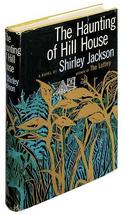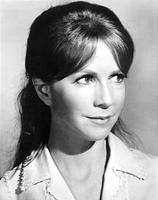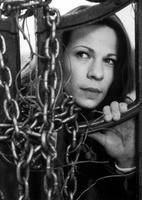by Shirley Jackson
[extended as of 9/23/05]
Okay, but the book I read was retitled The Haunting, so as to be absolutely unambiguously identifiable as being a tie-in with the 1999 movie of the same name. I guess Penguin (or, more likely, DreamWorks) thought that using the movie poster for the cover wasn’t clear enough. And they sure as hell weren’t going to be bullied into some kind of wimpy compromise like reducing the size of “of Hill House.” No time for that crap: marketing is serious business and we’re not taking any chances. Out of the way, Shirley! They even went in and erased half of the running heads – “OF HILL HOUSE” appeared on the right-hand pages, originally, but in this edition (otherwise a direct offset) they were blank. Unfortunately, when Ms. Zeta-Jones was going through the book with white-out, she missed a spot – at one point, a chapter begins on a right-hand page, and since there’s no running head on the first pages of chapters, the whole head is on the left-hand page, where it has the temerity to remember the complete title.
Those marketing guys sure know what they’re doing: I bought this copy for exactly $1 in the über-discount bin.
Oh well, that’s not really fair. The tie-in edition is only meant to be sold for a few months, and for all I know, it might well have sold better than it would have otherwise because it had been retitled. One copy left in the beach bookstore doesn’t mean anything. All I’m saying is that I, an investor in neither Penguin nor DreamWorks, wish it hadn’t been done.
The book is short and I very much enjoyed reading it. Some – maybe a lot – of my enjoyment was in the very fact that I was reading a short, classic haunted house novel from 1959. What a delightful thing to be doing! The rest of my enjoyment – maybe less than half – was in the book itself. But the two kinds of enjoyment were intertwined.
The two things that pleased me most about the book: 1) It took on the task of being a “haunted house novel” and succeeded. The haunted house is one of those notions (“memes”) that are well-formed in the cultural consciousness and yet don’t have any clear “key text.” This is also how I felt about the movie Pirates of the Caribbean (perhaps not coincidentally the other major non-movie Disneyland ride) – that the screenwriters had done a great job building a framework from scratch to support all these previously untethered concepts about cursed treasure and ghost pirate sieges and so on. We all know that haunted houses have doors that close by themselves and creepy libraries gathering dust, etc. etc., but what is the story framework into which these things fit? It’s a difficult task, to keep the beloved details alive while you’re weaving them into a larger structure, when previously they were just loosely-related free-range thingies – a good description of what one sees on any Disneyland ride. Those rides all end up being more lists than narratives. This book did a very nice job turning a standard list into a reasonable narrative and still preserving the flavor of the list intact.
She actually accepts that she’s working with old materials, and has the characters all be quite aware of the haunted house clichés into which they’re stepping. The premise of the story is that a haunted house scholar is delighted to have found a real haunted house, and brings a couple of psychically susceptible types there so that he can study it. He and the other characters all talk about haunted houses the same way you or I might; they know all about them, and to them, the only thing novel about their situation is that they are actually in such a house. The quasi-knowing attitude of the characters toward their genre goes a long way toward bringing the atmosphere to life. Unlike in Scream, it’s not used for some kind of winking, meta-clever ends. It’s just a way of letting the book be firmly inside an absurd and naive genre without seeming too absurd or naive. When scary, ghostly stuff is happening, they nervously joke about how it seems to really be happening. That might be an old device but it was used effectively here and I appreciated it.
2) Shirley Jackson’s writing is uncluttered and firm and very pleasant to read. It is careful and writerly, but in a pared-down, completely unpretentious way. The very existence of this sort of thoughtful, tough “middlebrow” voice seemed like it dated the book. Where is this voice today? I feel like there is a psychological over-transparency to contemporary writing, where intelligence feels the need to parade itself in the text. Maybe I just feel that way because I am so used to the gimmicks of contemporary writing that I see past them, whereas I was blinded by the old 1959 gimmicks in Jackson’s writing. Still, there’s something inherently appealing to me about that cold, quiet style, girded by a dark hum of knowingness, and I hadn’t read anything quite like it in a while. There is something effective for horror writing – or for any writing, really – about calmly, boldly leaving things unsaid, or what’s equally bold, giving simple two-word descriptions to things about which the reader has at least ten words of curiosity. A strong sense of purpose seems to govern every sentence.
But the cold 50’s-ness of it goes beyond that. A thought I had while reading the book was that everyone has a clear sense of the distinctive personality of “30’s dialogue,” but you don’t generally hear about other eras, like “60’s dialogue,” even though I think it probably has just as distinctive a character. The dialogue in the book was all a kind of would-be casual would-be repartee that was meant to portray guarded, brittle pseudo-camaraderie on the part of the various houseguests. But the brittle quality went well beyond anything in real life – there was something lightheaded and ringing about every jaunty line. The characters’ jokes and insincerities come off like some kind of heightened, dream-like ceremony in masks. To me anyway! I was reminded of my impressions, when I was younger, when reading Who’s Afraid of Virginia Woolf? (1962) and Rosemary’s Baby (1967). All the vernacular stuff somehow seemed infused with a slightly maniacal overemphasis. In all three works there is a theme of revealing how hollow it all is, but choosing to do so by giving it that crazed falseness is very much of the era. Probably this fits in to someone’s theory of literature during the Cold War, but I’m not really interested in going that far right now; I’m just talking about dialogue. In the movie of The Graduate (1967, book 1963), the loopy intensity of crass commonplaces is actually played for laughs.
Not so here. The Haunting of Hill House, in its dialogue, overall style, theme and construction, achieves a very particular kind of eerie effect. “Floating horror” or “lightheaded horror” I’m tempted to call it – it’s not fear of anything, exactly, but just the increasingly unnerving sense that arises from never being allowed to touch solid ground. The narrative starts off hovering uneasily on the line between the protagonist’s external world and her anxious, flighty inner life, and then proceeds to hover there for the remainder of the book. It works very well, though at times the details (what exactly is going on between these characters? what exactly is happening now?) get a bit murkier than necessary, or get murky earlier than is reasonable. It’s a book all about executing a slow burn, and page for page, the pacing of that slow burn isn’t always exactly right. But it’s not a big problem.
I just looked up “slow burn” and it apparently only means a gradual “display of anger,” but I want to use it to mean any very gradual change from a neutral state to some other state. Is there another expression for that?
The Shining owes an obvious (and probably acknowledged) debt to this. Apparently the Robert Wise movie version is quite good, and Shirley herself liked it, so I’ve got to see that. The 1999 version is, by contrast, supposed to be a big dud. But I might have to see that too.
Here’s the original edition cover, which is kind of dated – but I like that it’s sort of reserved about showing the house (unlike the current cover, not to mention the cover on my copy).
And here’s Shirley Jackson as she appeared when she was the age of her protagonist, which is pretty much how I was picturing the woman in the book. Your Hollywood choices follow.
[ONE DAY LATER, 9/23]
Something I planned to mention but forgot – there is a brilliant stroke toward the end of the book. Just as you begin to feel that the protagonist is in peril, the author suddenly brings in two new loud comic characters who irritate everyone and are completely insensitive to the creepy atmosphere. This is at the three-quarters mark, or further. It’s a really clever device, because it very effectively heightens the reader’s sense of hopelessness. The only real struggle, for the characters in this book, is just to keep their wits about them and stay level and focussed in the face of all that “floating horror” uneasiness. Just as that task gets dangerously hard, the author throws a couple of annoying people in their (and our) faces. On the surface, it seems like the new characters completely ruin the atmosphere – but in fact they allow Shirley’s slow burn to run nice and cold all the way to the end, because now the horror has to be glimpsed only in the background, behind the stupid people. Ingenious, really.
Rather than the standard horror movie “don’t go in there!” we want to shout “shut up! we need to concentrate!” Which ends up feeling like a more sophisticated version of the same thing.
In thinking about this device and why it isn’t used more often, I was reminded of the similar effect in the scene in Punch-Drunk Love where cruelly distracting drumming in the incidental score creates the sense that the mundane conversation being had is in fact frightening and difficult. (The same director does something comparable in Boogie Nights, in the tense scene during which a kid keeps unexpectedly setting off loud firecrackers nearby). There, as here, that particular sense of urgency that arises from being distracted has been harnessed. But The Haunting of Hill House does P.T. Anderson one or two better, by making the distraction something amusing in its own right.



